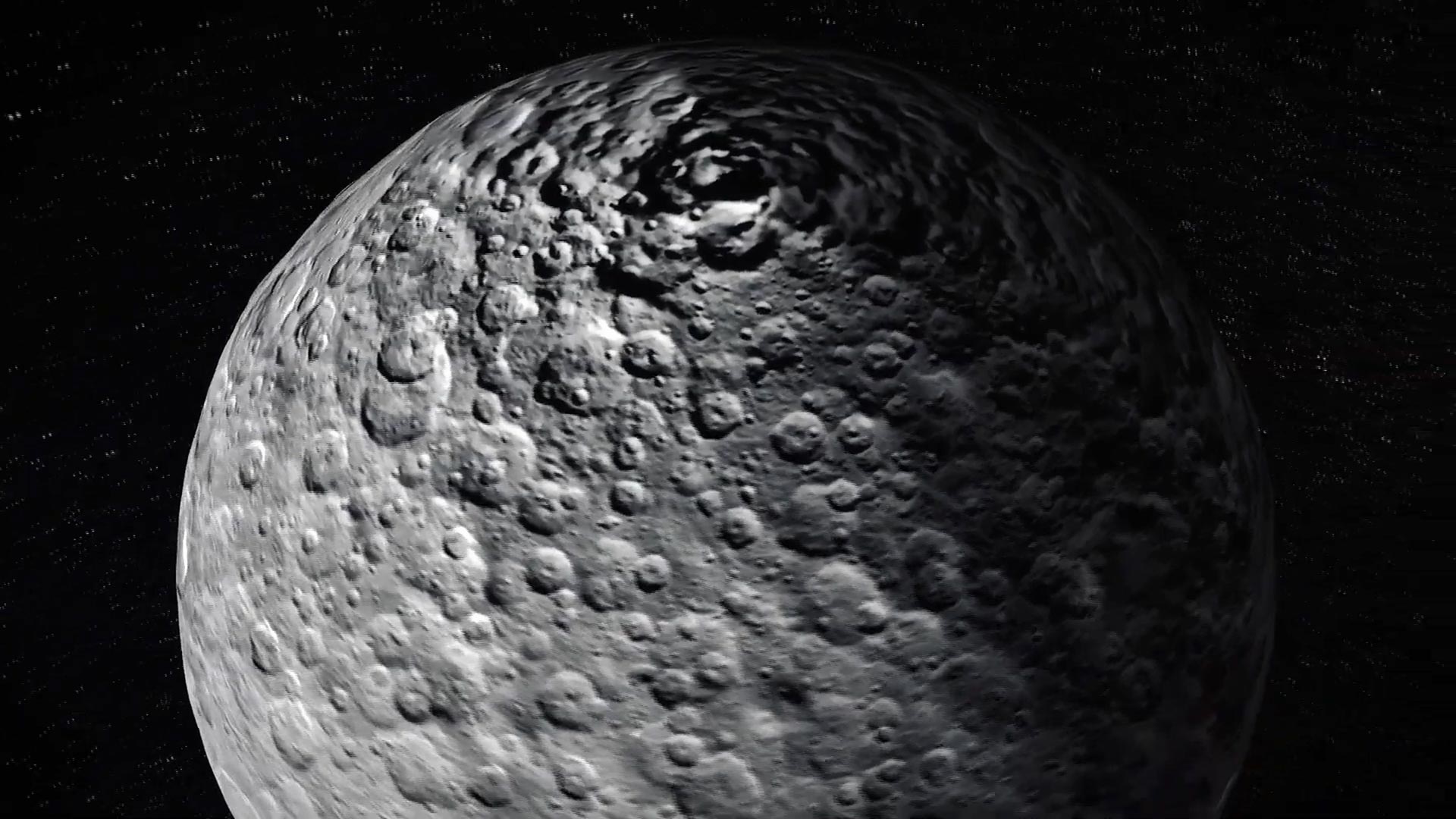science
La planète naine Ceres à son plus brillant

Une image de la planète naine Ceres basée sur les observations faites par le vaisseau spatial Dawn de la NASA. Ce mois-ci, la planète naine Cérès est la plus brillante, ce qui signifie que vous pouvez la rechercher avec des jumelles ou un petit télescope. Crédit : NASA
Quels sont quelques-uns des temps forts de l’observation du ciel en mars 2023 ? Après avoir approché le ciel le 1er mars,[{ » attribute= » »>Venus and Jupiter go their separate ways. Venus climbs higher each evening, while Jupiter exists in the morning sky at month’s end. And those with binoculars or a small telescope can seek out dwarf planet Ceres, which is at its brightest this month.
Vénus et Jupiter se séparent après leur rencontre du 1er mars, tandis que Cérès atteint l’opposition, ce qui vaut la peine d’être surveillé pour utiliser des jumelles.
- tout au long du mois Jupiter et Vénus peuvent être vus à l’ouest après le coucher du soleil. Les deux planètes ont commencé le mois très près l’une de l’autre le 1er mars, mais s’éloignent chaque nuit tout au long du mois.
- tout au long du mois La planète naine Cérès est en opposition en mars, ce qui signifie qu’elle est visible toute la nuit et qu’elle est la plus brillante au cours de l’année. Vous pouvez le trouver avec des jumelles ou un petit télescope, avec la constellation du Lion comme guide.
- Il marche 7 – pleine lune
- Il marche 21 – Nouvelle Lune
- Il marche 23 – Regardez vers l’ouest pour trouver la lune un beau croissant mince ce soir après le coucher du soleil, suspendu sous la brillante planète Vénus.
- Il marche 24 – Après le coucher du soleil, cherchez la lune à l’ouest avec un beau croissant élancé planant au-dessus de la brillante planète Vénus.
- Il marche 25 – Le croissant de lune se trouve à côté de l’amas d’étoiles brillantes des Pléiades ce soir

La planète naine Cérès est représentée dans ces conceptions en fausses couleurs, qui mettent en évidence les différences de matériaux de surface. Crédit : NASA/JPL
Cérès, le plus gros objet de la ceinture d’astéroïdes entre eux[{ » attribute= » »>Mars and Jupiter, is the sole dwarf planet situated in the inner solar system. Giuseppe Piazzi first detected it in 1801, making it the first asteroid belt member to be found. In 2015, NASA’s Dawn spacecraft visited Ceres, making it the first dwarf planet to be visited by a spacecraft.
Regarded as an asteroid for many years, Ceres is considerably more massive and distinct from its neighboring rocky bodies. As a result, scientists designated it a dwarf planet in 2006. Even though it represents 25% of the asteroid belt’s total mass, it is dwarfed by Pluto, which is 14 times more massive.
The Roman goddess of corn and harvests, Ceres, lends her name to this celestial body. The word cereal is derived from the same root.
Video Transcript
What’s Up for March? Venus climbs high while Jupiter dives sunward, and the little planet that shares its namesake with your breakfast cereal.
Venus and Jupiter begin the month very close together in the evening sky, following their close conjunction on March 1st. They quickly go their separate ways, though. Venus climbs higher in the sky each night for the next couple of months, while Jupiter dives after the Sun. The giant planet appears lower in the sky each night through the month, making its exit as an evening object. It’ll reappear in May, in the pre-dawn sky, with Saturn.

Jupiter appears lower in the sky each night through the month of March 2023, making its exit as an evening object. Credit: NASA/JPL-Caltech
On the 23rd and 24th, in the couple of hours after sunset, you’ll find the Moon as a beautifully slim crescent hanging just below, and the next night above, blazing bright Venus. Then, on the 25th, the Moon continues upward in the sky, landing right next to the brilliant Pleiades star cluster that night.
With March bringing the arrival of spring in the Northern Hemisphere and fall in the Southern Hemisphere, it’s a time for both planting or harvesting crops, depending on where you live. So it’s perhaps a fitting time to try and spot the planet named for a mythical goddess of agriculture, grains, and fertile lands. (In addition to being the origin of the word “cereal.”)
That’s dwarf planet Ceres. This month it’s at opposition, meaning it’s directly on the opposite side of Earth from the Sun. This is when a planet is around its shortest distance from Earth, making this the best time to have a go at observing it when it’s at its brightest.

Although the dwarf planet Ceres is the largest object in the main asteroid belt between Mars and Jupiter, it’s still far smaller than our own Moon. Credit: NASA/JPL-Caltech
Ceres is the largest object in the main asteroid belt between Mars and Jupiter. Still it’s only about 600 miles wide – far smaller than our own Moon. Its dusty surface is peppered with impact craters, with bright salt deposits here and there, that hint at the possibility of slushy, briny ice beneath. In fact, NASA’s Dawn spacecraft found that Ceres could be up to one-quarter water ice on the inside.
Now, Ceres is too faint to see with the unaided eye, so to locate it in the March sky, you’ll need binoculars or a small telescope. Find the lion constellation Leo in the southeast after around 9 pm. The bright, bluish-white star Regulus (the lion’s heart) should catch your eye first. Then look eastward about 25 degrees to find Denebola, which represents the lion’s tail. From there Ceres should be 8 or 9 degrees farther east from Denebola. It appears as a faint, star-like point of light – which is why, when Ceres and objects like it were first discovered in the early 19th century, they were called “asteroids,” which means “starlike.”

Ceres’ position in the sky during March 2023. Credit: NASA/JPL-Caltech
Since 2006, Ceres has been classified as a dwarf planet – along with other diminutive worlds in our solar system including Pluto, Eris, Haumea, and Makemake. Wherever you land on the topic of “planet vs. dwarf planet” -status for worlds like Ceres and Pluto, what’s really important to remember is that the way we think about different families of objects in our solar system has evolved over time, and likely will continue to evolve as we explore and learn more about them. So here’s hoping you try your hand at spotting Ceres as you explore the skies above your home planet this month.
Here are the phases of the Moon for March.

The phases of the Moon for March 2023. Credit: NASA/JPL-Caltech
Stay up to date with all of NASA’s missions to explore the solar system and beyond at nasa.gov. I’m Preston Dyches from NASA’s Jet Propulsion Laboratory, and that’s What’s Up for this month.

« Spécialiste de la télévision sans vergogne. Pionnier des zombies inconditionnels. Résolveur de problèmes d’une humilité exaspérante. »
science
Une exoplanète radioactive découverte lors d'une « tempête de marée parfaite »

Les forces de marée peuvent-elles provoquer un rayonnement de chaleur à la surface d’une exoplanète ? C'est ce qu'un Étude récente acceptable pour Revue astronomique Une équipe de chercheurs internationaux espère traiter les données collectées à partir d’instruments au sol pour confirmer l’existence d’une deuxième exoplanète résidant au sein du système exoplanétaire. HD 104067, tout en utilisant la mission Transiting Exoplanet Survey Satellite (TESS) de la NASA pour identifier également une exoplanète candidate supplémentaire. Ce qui est unique à propos de cette planète candidate, qui orbite plus profondément que les deux autres, est que les forces de marée émergeant des deux exoplanètes les plus externes font probablement rayonner la surface de la candidate avec une température de surface atteignant 2 300 degrés Celsius (4 200 degrés). Fahrenheit), que les chercheurs appellent la « tempête de marée parfaite ».
ici, L'univers aujourd'hui Discute de cette recherche fascinante avec Dr Stephen Kane, professeur d'astrophysique planétaire à l'Université de Californie à Riverside et auteur principal de l'étude, concernant les motivations derrière l'étude, les résultats importants, l'importance des aspects de « tempête de marée » et des recherches de suivi, ainsi que les implications de ce système pour l'étude d'autres systèmes exoplanétaires. Alors, quelle était la motivation derrière cette étude ?
« L'étoile (HD 104067) était connue pour abriter une planète géante sur une orbite de 55 jours, et j'ai une longue histoire d'obsession pour les systèmes connus », explique le Dr Kane. L'univers aujourd'hui. «Lorsque TESS a détecté une planète potentielle en transit de la taille de la Terre sur une orbite de 2,2 jours (TOI-6713.01), j'ai décidé d'examiner plus en détail le système. Nous avons collecté toutes les données du vaisseau spatial et avons découvert qu'il y avait une autre planète (de masse Uranus) en orbite. sur une orbite de 13 jours. Cela a donc commencé avec les données TESS, et le système est devenu plus intéressant à mesure que nous l'étudiions.
L'histoire du Dr Kane dans la recherche sur les exoplanètes comprend d'innombrables structures du système solaire, en particulier celles contenant des exoplanètes très excentriques, mais comprend également des travaux de suivi après confirmation de la présence d'exoplanètes dans le système. Plus récemment, il fut le deuxième auteur de Stade Discussion sur la structure révisée du système HD 134606, ainsi que sur la découverte de deux nouvelles super-Terres au sein de ce système également.
Dans cette dernière étude, le Dr Kane et ses collègues ont utilisé les données des instruments HARPS (High Resolution Radial Velocity Planet Search), du spectromètre Echelle haute résolution (HIRES) et de la mission TESS susmentionnée pour vérifier les propriétés et les paramètres des deux. L'étoile mère, HD 105067, et les exoplanètes correspondantes en orbite autour d'elle. Cependant, outre la découverte d’exoplanètes supplémentaires au sein du système, comme le mentionne le Dr Kane, quels sont les résultats les plus importants obtenus par cette étude ?
dit le Dr Kane L'univers aujourd'hui« Le résultat le plus surprenant de notre travail a été que la dynamique du système lui a fait subir des effets de marée massifs sur une période de 2,2 jours, similaires à ceux subis par Io. Cependant, dans ce cas, TOI-6713.01 subit une énergie de marée de 10 millions. fois supérieur à Io, ce qui donne 2600K. [2,300 degrees Celsius (4,200 degrees Fahrenheit)] Température superficielle. Cela signifie que la planète brille réellement aux longueurs d’onde de la lumière.
La lune de Jupiter, Io, est le corps planétaire le plus volcaniquement actif du système solaire, qui est produit par le réchauffement des marées provoqué par l'immense gravité de Jupiter tout au long de l'orbite légèrement excentrique (allongée) de 1,77 jours d'Io. Cela signifie que Io s'approche de Jupiter à certains points et s'en éloigne à d'autres points, provoquant respectivement la compression et l'expansion d'Io. Pendant des millions d'années, cette friction constante à l'intérieur d'Io a réchauffé son noyau, donnant naissance aux centaines de volcans qui composent la surface d'Io, ainsi qu'à l'absence de cratères d'impact visibles. Comme le note le Dr Kane, cette nouvelle exoplanète candidate « connaît 10 millions de fois plus d’énergie de marée que Io », ce qui pourrait soulever des questions supplémentaires concernant son activité volcanique ou d’autres processus géologiques. Par conséquent, quelle est la signification des aspects « tempête de marée » du TOI-6713.01 ?
dit le Dr Kane L'univers aujourd'hui« La raison pour laquelle TOI-6713.01 est soumis à de fortes forces de marée est due à l'excentricité des deux planètes géantes extérieures, forçant également TOI-6713.01 à se placer sur une orbite excentrique. Ainsi, j'ai fait référence à la planète comme étant prise dans une pleine tempête de marée. .»
Le système HD 104067 avec deux exoplanètes géantes forçant le TOI-6713.01 le plus intérieur dans une « tempête de marée parfaite » rappelle un peu les trois premières lunes galiléennes de Jupiter, Io, Europe et Ganymède, en ce qui concerne leurs influences gravitationnelles les unes sur les autres tout au long de leur vie. orbites. . Cependant, il existe quelques différences, puisque l'immense gravité de Jupiter est la principale force à l'origine de l'activité volcanique de Io, et que les trois lunes sont situées dans ce que l'on appelle Résonance orbitaleCe qui signifie que les orbites sont proportionnelles les unes aux autres. Par exemple, pour quatre orbites d'Io, il y a deux orbites d'Europe et une orbite de Ganymède, ce qui rend leur résonance orbitale 4:2:1, ce qui amène chaque lune à exercer des influences gravitationnelles régulières l'une sur l'autre. Ainsi, bien que l’aspect tempête de marée sur TOI-6713.01 soit causé par l’excentricité des géantes extérieures, comment cela se compare-t-il à la relation entre Io, Europe et Ganymède ?
« La résonance de Laplace des lunes de Galilée crée une configuration particulièrement forte, car l'alignement régulier des trois lunes intérieures force régulièrement Io sur une orbite excentrique », explique le Dr Kane à Universe Today. « Le système HD 104067 n'est pas en résonance mais l'est. toujours capable de produire une configuration énergétique.
Comme mentionné, TOI-6713.01 a été découvert à l'aide de la méthode de la vitesse radiale, également connue sous le nom de spectroscopie Doppler, ce qui signifie que les astronomes ont mesuré de minuscules changements dans le mouvement de l'étoile mère lorsqu'elle était légèrement entraînée par la planète pendant l'orbite de cette dernière. Ces changements subtils font vaciller l'étoile mère lorsque les deux objets s'attirent, et les astronomes utilisent des spectrographes pour détecter les changements dans cette oscillation lorsque l'étoile se rapproche et s'éloigne de nous pour trouver des exoplanètes. Cette méthode s'est avérée très efficace pour trouver des exoplanètes Cela représente environ 20 pour cent Sur le nombre total d'exoplanètes confirmées jusqu'à présent, et La première exoplanète en orbite autour d’une étoile comme la nôtre Il a également été découvert grâce à cette méthode. Cependant, malgré l’efficacité de la vitesse radiale, l’étude note que TOI-6713.01 « n’a pas encore été confirmé », alors quelles observations supplémentaires seraient nécessaires pour confirmer son existence ?
dit le Dr Caines L'univers aujourd'hui« La planète étant si petite, elle est difficile à détecter à partir des données de vitesse radiale. Cependant, le transit semble propre et nous avons exclu la possibilité d'une contamination stellaire supplémentaire, mais nous sommes tout à fait convaincus que la planète existe à ce stade. .»
Cette étude intervient alors que le nombre total de systèmes exoplanétaires s'élève à environ 4 200, avec un nombre d'exoplanètes confirmées supérieur à 5 600 et plus de 10 100 exoplanètes candidates également en attente de confirmation. Il a été constaté que ces structures de système diffèrent considérablement de notre système solaire, qui est constitué de planètes telluriques (rocheuses) les plus proches du Soleil et de géantes gazeuses situées sur des orbites beaucoup plus éloignées. Les exemples comprennent Jupiter chaud Cette orbite dangereusement proche de leur étoile mère, certains en quelques jours seulement, et d'autres systèmes Il comprend sept exoplanètes de la taille de la Terreet certains d'entre eux tournent à l'intérieur Zone habitable. Alors, que peut nous apprendre cette structure unique du système solaire sur les systèmes exoplanétaires en général, et que reflètent les autres systèmes exoplanétaires ?
dit le Dr Kane L'univers aujourd'hui« Ce système est un excellent exemple des environnements extrêmes dans lesquels les planètes peuvent se trouver. Il y a eu plusieurs cas de planètes telluriques proches de leur étoile et chauffées par l'énergie de l'étoile, mais très peu de cas où l'énergie marémotrice fait fondre la planète. l'intérieur. »
La découverte potentielle d'une exoplanète en orbite dans une « tempête de marée parfaite » illustre une myriade de caractéristiques que présentent les exoplanètes et les systèmes exoplanétaires, tout en contrastant avec notre propre système solaire et ce que les astronomes en ont appris jusqu'à présent. S'il est confirmé, TOI-6713.01 continuera de façonner notre compréhension de la formation et de l'évolution des exoplanètes et des systèmes exoplanétaires, non seulement dans notre Voie lactée, mais également dans tout l'univers.
« L'univers est un endroit merveilleux ! » dit le Dr Kane L'univers aujourd'hui. « Ce qui est amusant dans ce projet en particulier, c'est que tout a commencé par « Hmm… ça pourrait être intéressant » et s'est ensuite transformé en quelque chose de bien plus fascinant que ce que j'aurais pu imaginer. Allez voir le spectacle, ne manquez jamais l'occasion de le faire ! poursuivez votre curiosité.
Comment cette exoplanète de tempête de marée nous apprendra-t-elle sur les exoplanètes et autres systèmes exoplanétaires dans les années et décennies à venir ? Seul le temps nous le dira, c'est pourquoi nous étudions !
Comme toujours, continuez à faire de la science et continuez à rechercher !

« Spécialiste de la télévision sans vergogne. Pionnier des zombies inconditionnels. Résolveur de problèmes d’une humilité exaspérante. »
science
Les astronomes présentent un nouveau modèle pour la formation de planètes « flottantes » récemment découvertes

La découverte récente d’une nouvelle classe potentielle de planètes lointaines et mystérieuses « flottantes » a suscité l’intérêt des astronomes depuis que de nouvelles images époustouflantes prises par le télescope spatial James Webb ont été partagées à la fin de l’année dernière.
Ces planètes candidates, connues sous le nom d'objets binaires de masse Jupiter (JuMBO), semblent tourner autour les unes des autres car elles flottent librement dans l'espace, sans être attachées à aucune étoile, ce qui contredit les théories dominantes sur le fonctionnement des systèmes planétaires.
Aujourd'hui, une nouvelle étude révolutionnaire réalisée par une équipe d'astrophysiciens de l'UNLV et de l'Université de Stony Brook a été publiée le 19 avril dans la revue Astronomie naturelleIl fournit un modèle convaincant de la façon dont ces organismes massifs se sont formés.
L’équipe a utilisé des techniques avancées, connues sous le nom de simulations directes à N corps, pour explorer comment les interactions au sein d’amas d’étoiles denses pourraient éjecter des planètes géantes qui restent liées entre elles par la gravité lorsqu’elles dérivent à travers la galaxie. Cette recherche importante fournit un modèle sur la façon dont ces mystérieux binaires se forment, comblant ainsi une lacune critique dans notre compréhension de l’évolution planétaire.
« Nos simulations montrent que des rencontres stellaires rapprochées pourraient éjecter spontanément des paires de planètes géantes de leurs systèmes d'origine, les obligeant à orbiter l'une autour de l'autre dans l'espace », a déclaré l'auteur de l'étude Yihan Wang, chercheur postdoctoral au Centre d'astrophysique du Nevada à l'UNLV. « Ces résultats pourraient changer radicalement notre perception de la dynamique planétaire et de la diversité des systèmes planétaires de notre univers. »
La recherche indique que de tels événements sont plus susceptibles de se produire au sein d’amas d’étoiles densément peuplés, ce qui suggère que les planètes binaires flottantes pourraient être plus courantes qu’on ne le pensait auparavant. Les propriétés de ces paires planétaires, telles que leur séparation et leur excentricité orbitale, fournissent de nouvelles informations sur les conditions environnementales violentes qui influencent la formation des planètes.
« Il présente les interactions stellaires dynamiques comme un facteur important dans le développement de systèmes planétaires inhabituels dans des environnements stellaires denses », a déclaré Rosalba Perna, co-auteur de l'étude et professeur de physique et d'astronomie à l'Université de Stony Brook.
Selon les chercheurs, ces nouveaux travaux élargissent nos connaissances sur la formation planétaire et ouvrent également la voie à de futures observations utilisant le télescope spatial James Webb (JWST), qui pourraient fournir davantage de preuves à l'appui des prédictions de l'équipe.
« Comprendre la formation d'objets massifs nous aide à remettre en question et à améliorer les théories dominantes sur la formation planétaire », a déclaré Zhaohuan Zhu, astrophysicien à l'UNLV et co-auteur de l'étude. « Les observations du télescope spatial James Webb peuvent nous aider à y parvenir, en fournissant de nouvelles informations avec chaque observation qui nous aideront à mieux formuler de nouvelles théories sur la formation des planètes géantes. »
À propos du papier
« Planètes binaires flottant librement suite à leur éjection lors de rencontres stellaires rapprochées», a été publié le 19 avril dans le magazine Astronomie naturelle.

« Spécialiste de la télévision sans vergogne. Pionnier des zombies inconditionnels. Résolveur de problèmes d’une humilité exaspérante. »
science
Aperçu de la croissance des plantes et des maladies humaines

Un criblage de suppresseur génétique identifie le RdDM comme une voie majeure pour le silençage épigénétique induit par une expansion répétée. une, Phénotypes (indiqués par leurs identifiants d'écran d'origine) des suppresseurs isolés par rapport à Bur-0. Les feuilles irrégulièrement faibles sont marquées par des flèches blanches chez le type sauvage Bur-0. Barres d'échelle, 2 cm. Brelatif III1 Niveaux d'expression de suppresseurs de gènes identifiés par criblage génétique. Les nombres représentent les identifiants d'écran d'origine et les gènes correspondants identifiés après le clonage sont indiqués ci-dessous. Niveaux d'expression moyens basés sur trois répétitions biologiques pour chaque lignée (à l'exclusion de Bur-0 et fug1où n = 5 et 4, respectivement). Astérisques Indiquez les points de données individuels. sLes valeurs sont basées sur une analyse de variance unidirectionnelle avec le test post hoc de Tukey, et les polices avec des lettres différentes sont significativement différentes les unes des autres (s <0,05). Les barres d'erreur représentent s.e.mC Exemple d'analyse SHOREmap utilisant 44-2 Définit une mutation dans Paul F. . Les allèles à haute fréquence (> 0,85) sont colorés en rouge et les croix rouges représentent les allèles causals putatifs. crédit:Plantes naturelles
(2024). est ce que je: 10.1038/s41477-024-01672-5 ×
Fermer Un criblage de suppresseur génétique identifie le RdDM comme une voie majeure pour le silençage épigénétique induit par une expansion répétée.une , Phénotypes (indiqués par leurs identifiants d'écran d'origine) des suppresseurs isolés par rapport à Bur-0. Les feuilles irrégulièrement faibles sont marquées par des flèches blanches chez le type sauvage Bur-0. Barres d'échelle, 2 cm.B relatif III1 Niveaux d'expression de suppresseurs de gènes identifiés par criblage génétique. Les nombres représentent les identifiants d'écran d'origine et les gènes correspondants identifiés après le clonage sont indiqués ci-dessous. Niveaux d'expression moyens basés sur trois répétitions biologiques pour chaque lignée (à l'exclusion de Bur-0 et fug1 oùn = 5 et 4, respectivement). Astérisques Indiquez les points de données individuels.sLes valeurs sont basées sur une analyse de variance unidirectionnelle avec le test post hoc de Tukey, et les polices avec des lettres différentes sont significativement différentes les unes des autres ( s<0,05). Les barres d'erreur représentent s.e.m C Exemple d'analyse SHOREmap utilisant 44-2Définit une mutation dans Paul F.. Les allèles à haute fréquence (> 0,85) sont colorés en rouge et les croix rouges représentent les allèles causals putatifs. crédit:
Plantes naturelles (2024). est ce que je: 10.1038/s41477-024-01672-5 Les biologistes de l'Université Monash ont mis en lumière les mécanismes moléculaires complexes responsables de l'inactivation des gènes provoquée par des répétitions étendues dans une étude internationale. publiéaujourd'hui dans
Plantes naturelles
.
Ce phénomène a été associé à un certain nombre de maladies génétiques, notamment l'ataxie de Friedreich chez l'homme, et provoque des anomalies de développement chez des plantes telles qu'Arabidopsis thaliana.
La recherche vise à comprendre le mécanisme par lequel les répétitions amplifiées provoquent l’inactivation des gènes, une procédure clé pour contrôler l’expression des gènes.
Les nouveaux composants nécessaires à ce processus de mise au silence ont été découverts par des chercheurs à l'aide d'un modèle végétal qui présente des symptômes de défauts de croissance à des températures plus élevées mais pas à des températures plus basses.
La protéase SUMO FUG1, le lecteur d'histone AL3 et la protéine chromodomaine LHP1 ont été identifiés comme les trois acteurs les plus importants, selon l'étude.
« Ces protéines se réunissent pour créer une unité de base requise pour l'inactivation des gènes résultant d'une expansion répétée », a déclaré le Dr Sridevi Sureshkumar, auteur principal de l'étude, qui dirige le groupe de recherche génétique du groupe de recherche fondamentale de l'école des sciences biologiques de l'université Monash.
« Notre recherche révèle le rôle essentiel que jouent ces protéines dans la coordination de l'inactivation génique résultant de répétitions étendues », a déclaré le Dr Sureshkumar.
« La connaissance de ces systèmes fait non seulement progresser notre compréhension de la biologie végétale, mais donne également un aperçu des maladies humaines », a-t-elle déclaré.
Au cours de la recherche, des méthodes modernes de criblage génétique et des tests à deux hybrides sur levure ont été utilisés afin de déterminer que FUG1, une protéase SUMO non caractérisée, joue un rôle important dans l’inactivation des gènes. Après une analyse plus approfondie, il a été démontré que FUG1 interagissait avec AL3, un lecteur d'histone connu pour se lier à des marques d'histone spécifiques associées à une expression génique efficace.
De plus, les chercheurs ont découvert que la protéine AL3 interagit avec LHP1, une protéine chromodomaine qui joue un rôle dans la propagation des marques d'histone restreintes. L'inversion de l'inactivation des gènes et la suppression des symptômes associés à une expansion récurrente se sont produites en raison de la perte de fonction de l'un de ces composants au cours de l'expérience.
« Ces résultats mettent en valeur l’importance des modificateurs post-traductionnels et des lecteurs d’histone dans la régulation épigénétique », a déclaré le Dr Sureshkumar.
Elle a déclaré : « Notre étude ouvre la voie à des recherches plus approfondies sur le rôle de ces protéines dans divers processus biologiques et maladies humaines. »
« Les résultats représentent non seulement des conséquences potentielles pour la santé humaine, mais contribuent également à notre compréhension de la biologie végétale, qui est déjà avancée. »
Le Dr Sureshkumar, qui a dirigé cette étude internationale incluant des institutions du Royaume-Uni, de Chine, du Canada, d'Inde et d'Australie, a déclaré que la collaboration multinationale les avait aidés à progresser dans divers aspects de cette recherche.
Le Dr Sureshkumar a déclaré que cette recherche pourrait ouvrir la voie au développement de nouvelles techniques thérapeutiques ciblant la dérégulation épigénétique chez les personnes atteintes de maladies génétiques. Plus d'information:Sridevi Sureshkumar et al, la protéase SUMO FUG1, le lecteur d'histone AL3 et la protéine chromodomaine LHP1 font partie intégrante du silençage génique induit par l'expansion de la réplication chez Arabidopsis thaliana. Plantes naturelles
Informations magazine : Plantes naturelles

« Spécialiste de la télévision sans vergogne. Pionnier des zombies inconditionnels. Résolveur de problèmes d’une humilité exaspérante. »
-
entertainment2 ans ago
Découvrez les tendances homme de l’été 2022
-
Top News2 ans ago
Festival international du film de Melbourne 2022
-
Tech1 an ago
Voici comment Microsoft espère injecter ChatGPT dans toutes vos applications et bots via Azure • The Register
-
science2 ans ago
Les météorites qui composent la Terre se sont peut-être formées dans le système solaire externe
-
science3 ans ago
Écoutez le « son » d’un vaisseau spatial survolant Vénus
-
Tech2 ans ago
F-Zero X arrive sur Nintendo Switch Online avec le multijoueur en ligne • Eurogamer.net
-
entertainment1 an ago
Seven révèle son premier aperçu du 1% Club
-
entertainment1 an ago
Centenaire des 24 Heures – La musique live fournit une bande-son pour la course








